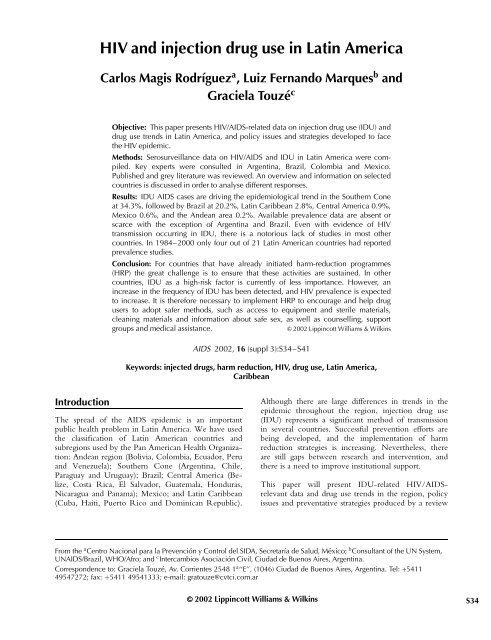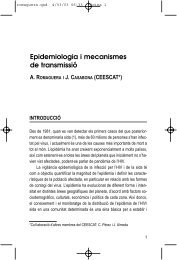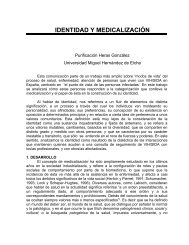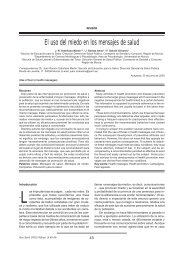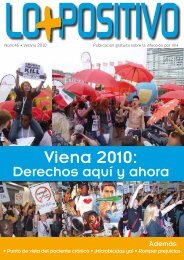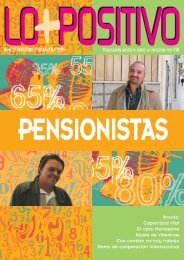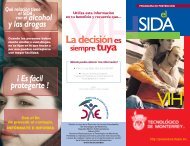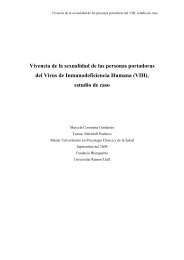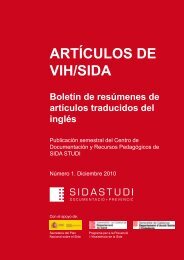HIV and injection drug use in Latin America - Sida Studi
HIV and injection drug use in Latin America - Sida Studi
HIV and injection drug use in Latin America - Sida Studi
You also want an ePaper? Increase the reach of your titles
YUMPU automatically turns print PDFs into web optimized ePapers that Google loves.
<strong>HIV</strong> <strong>and</strong> <strong><strong>in</strong>jection</strong> <strong>drug</strong> <strong>use</strong> <strong>in</strong> Lat<strong>in</strong> <strong>America</strong>Carlos Magis Rodríguez a , Luiz Fern<strong>and</strong>o Marques b <strong>and</strong>Graciela Touzé cObjective: This paper presents <strong>HIV</strong>/AIDS-related data on <strong><strong>in</strong>jection</strong> <strong>drug</strong> <strong>use</strong> (IDU) <strong>and</strong><strong>drug</strong> <strong>use</strong> trends <strong>in</strong> Lat<strong>in</strong> <strong>America</strong>, <strong>and</strong> policyissues <strong>and</strong> strategies developed to facethe <strong>HIV</strong> epidemic.Methods: Serosurveillance data on <strong>HIV</strong>/AIDS <strong>and</strong> IDU <strong>in</strong> Lat<strong>in</strong> <strong>America</strong> were compiled.Keyexperts were consulted <strong>in</strong> Argent<strong>in</strong>a, Brazil, Colombia <strong>and</strong> Mexico.Published <strong>and</strong> greyliterature was reviewed. An overview <strong>and</strong> <strong>in</strong>formation on selectedcountries is discussed <strong>in</strong> order to analyse different responses.Results: IDU AIDS cases are driv<strong>in</strong>g the epidemiological trend <strong>in</strong> the Southern Coneat 34.3%, followed byBrazil at 20.2%, Lat<strong>in</strong> Caribbean 2.8%, Central <strong>America</strong> 0.9%,Mexico 0.6%, <strong>and</strong> the Andean area 0.2%. Available prevalence data are absent orscarce with the exception of Argent<strong>in</strong>a <strong>and</strong> Brazil. Even with evidence of <strong>HIV</strong>transmission occurr<strong>in</strong>g <strong>in</strong> IDU, there is a notorious lack of studies <strong>in</strong> most othercountries. In 1984–2000 onlyfour out of 21 Lat<strong>in</strong> <strong>America</strong>n countries had reportedprevalence studies.Conclusion: For countries that have already<strong>in</strong>itiated harm-reduction programmes(HRP) the great challenge is to ensure that these activities are susta<strong>in</strong>ed. In othercountries, IDU as a high-risk factor is currentlyof less importance. However, an<strong>in</strong>crease <strong>in</strong> the frequencyof IDU has been detected, <strong>and</strong> <strong>HIV</strong> prevalence is expectedto <strong>in</strong>crease. It is therefore necessaryto implement HRP to encourage <strong>and</strong> help <strong>drug</strong><strong>use</strong>rs to adopt safer methods, such as access to equipment <strong>and</strong> sterile materials,clean<strong>in</strong>g materials <strong>and</strong> <strong>in</strong>formation about safe sex, as well as counsell<strong>in</strong>g, supportgroups <strong>and</strong> medical assistance.& 2002 Lipp<strong>in</strong>cott Williams & Wilk<strong>in</strong>sAIDS 2002, 16 (suppl 3):S34–S41Keywords: <strong>in</strong>jected <strong>drug</strong>s, harm reduction, <strong>HIV</strong>, <strong>drug</strong> <strong>use</strong>, Lat<strong>in</strong> <strong>America</strong>,CaribbeanIntroductionThe spread of the AIDS epidemic is an importantpublic health problem <strong>in</strong> Lat<strong>in</strong> <strong>America</strong>. We have <strong>use</strong>dthe classification of Lat<strong>in</strong> <strong>America</strong>n countries <strong>and</strong>subregions <strong>use</strong>d by the Pan <strong>America</strong>n Health Organization:Andean region (Bolivia, Colombia, Ecuador, Peru<strong>and</strong> Venezuela); Southern Cone (Argent<strong>in</strong>a, Chile,Paraguay <strong>and</strong> Uruguay); Brazil; Central <strong>America</strong> (Belize,Costa Rica, El Salvador, Guatemala, Honduras,Nicaragua <strong>and</strong> Panama); Mexico; <strong>and</strong> Lat<strong>in</strong> Caribbean(Cuba, Haiti, Puerto Rico <strong>and</strong> Dom<strong>in</strong>ican Republic).Although there are large differences <strong>in</strong> trends <strong>in</strong> theepidemic throughout the region, <strong><strong>in</strong>jection</strong> <strong>drug</strong> <strong>use</strong>(IDU) represents a significant method of transmission<strong>in</strong> several countries. Successful prevention efforts arebe<strong>in</strong>g developed, <strong>and</strong> the implementation of harmreduction strategies is <strong>in</strong>creas<strong>in</strong>g. Nevertheless, thereare still gaps between research <strong>and</strong> <strong>in</strong>tervention, <strong>and</strong>there is a need to improve <strong>in</strong>stitutional support.This paper will present IDU-related <strong>HIV</strong>/AIDSrelevantdata <strong>and</strong> <strong>drug</strong> <strong>use</strong> trends <strong>in</strong> the region, policyissues <strong>and</strong> preventative strategies produced by a reviewFrom the a Centro Nacional para la Prevención yControl del SIDA, Secretaría de Salud, México; b Consultant of the UN System,UNAIDS/Brazil, WHO/Afro; <strong>and</strong> c Intercambios Asociación Civil, Ciudad de Buenos Aires, Argent<strong>in</strong>a.Correspondence to: Graciela Touzé, Av. Corrientes 2548 1 a ‘‘E’’, (1046) Ciudad de Buenos Aires, Argent<strong>in</strong>a. Tel: +541149547272; fax: þ5411 49541333; e-mail: gratouze@cvtci.com.ar& 2002 Lipp<strong>in</strong>cott Williams & Wilk<strong>in</strong>sS34
<strong>HIV</strong> <strong>and</strong> <strong><strong>in</strong>jection</strong> <strong>drug</strong> <strong>use</strong> <strong>in</strong> Lat<strong>in</strong> <strong>America</strong> Rodríguez et al.S35of databases, National AIDS Programme (NAP) reports<strong>and</strong> published <strong>and</strong> grey literature sources. Key expertswith access to unpublished national data were consultedfor Argent<strong>in</strong>a, Brazil, Colombia <strong>and</strong> Mexico. A regionaloverview <strong>and</strong> <strong>in</strong>formation on selected countries will bediscussed.<strong>HIV</strong>/AIDS <strong>and</strong> <strong>drug</strong> <strong>use</strong> trendsAccord<strong>in</strong>g to UNAIDS, IDU is now a major form of<strong>HIV</strong> transmission worldwide. A total of 134 countriesreported documented cases of IDU <strong>in</strong> 1999, <strong>and</strong> 114 ofthem reported <strong>HIV</strong> <strong>in</strong>fection associated with IDU [1].As several studies conducted <strong>in</strong> Lat<strong>in</strong> <strong>America</strong> havefound, unprotected sex <strong>and</strong> <strong>drug</strong> <strong>use</strong>, with a risk of<strong>HIV</strong> transmission, is not conf<strong>in</strong>ed to IDU [2,3]. Theextent to which <strong><strong>in</strong>jection</strong> <strong>drug</strong> <strong>use</strong>rs <strong>and</strong> crack <strong>use</strong>rs,their sexual partners <strong>and</strong> offspr<strong>in</strong>g are affected by theepidemic <strong>in</strong> Lat<strong>in</strong> <strong>America</strong> varies <strong>in</strong> the differentregions <strong>and</strong> with<strong>in</strong> each country. Infection by IDUmakes up almost a third of the cases recorded <strong>in</strong>Argent<strong>in</strong>a, Chile, Paraguay <strong>and</strong> Uruguay [4]. In countriessuch as Paraguay <strong>and</strong> Bolivia, <strong>and</strong> <strong>in</strong> most of theCaribbean countries, the role of IDU is limited [2]. Incountries where <strong>in</strong>jected <strong>drug</strong>s are widely <strong>use</strong>d, such as<strong>in</strong> Argent<strong>in</strong>a <strong>and</strong> Brazil, there are different patterns ofthe epidemic.There are two superimposed trends <strong>in</strong> Lat<strong>in</strong> <strong>America</strong><strong>and</strong> the Caribbean: (i) The late 1990s explosion ofcrack <strong>use</strong> plays a key role <strong>in</strong> the regional <strong>HIV</strong>/AIDSepidemic, this can be observed <strong>in</strong> southeastern Brazil[5,6]; (ii) The recent <strong>in</strong>creased availability of opiumderivatives such as hero<strong>in</strong>, <strong>and</strong> the extent of its spread<strong>in</strong> Lat<strong>in</strong> <strong>America</strong>, has been the subject of debate,beca<strong>use</strong> its cultivation <strong>and</strong> sale is still a relatively recentdevelopment. Prelim<strong>in</strong>ary data show <strong>in</strong>creased consumption<strong>in</strong> different parts of Brazil [7]. In the Andeanarea <strong>and</strong> <strong>in</strong> Mexico its availability has <strong>in</strong>creased as aresult of new plant<strong>in</strong>gs, but for now its effect on localconsumption has been limited [8,9].IDU AIDS cases are driv<strong>in</strong>g the current epidemiologicaltrend <strong>in</strong> the Southern Cone countries at 34.3%,followed by Brazil at 20.2%. Meanwhile, <strong>in</strong> the Lat<strong>in</strong>Caribbean they represent 2.8%, Central <strong>America</strong> 0.9%,Mexico 0.6%, <strong>and</strong> the Andean area 0.2% [10]. Availabledata on IDU <strong>HIV</strong> prevalence are absent or scarce,with the exception of some studies <strong>in</strong> Argent<strong>in</strong>a <strong>and</strong>Brazil. Even with evidence of transmission marked byIDU AIDS cases, there is a notorious lack of studies <strong>in</strong>most other countries. In 1984–1998, only four out of21 Lat<strong>in</strong> <strong>America</strong>n countries reported prevalence <strong>in</strong> the<strong>HIV</strong>/AIDS Surveillance International Database [11], oron the UNAIDS EPI Fact Sheets [12] (see Table 1).Table 1. Injection <strong>drug</strong> <strong>use</strong> proportion of total AIDS cases.Country% of IDU AIDS casesArgent<strong>in</strong>a 41.9Belize 0Brazil 21.7Bolivia 3.5Chile 5Colombia 0.05Costa Rica 1.3Cuba 0Ecuador 0.6El Salvador 1.3GuatemalaSDHaitiSDHonduras 0.1Mexico 0.6Nicaragua 7.0Panama 2.5Paraguay11Peru 0.1Dom<strong>in</strong>ican Republic 3.5Uruguay26.3Venezuela 1.0IDU, Injection <strong>drug</strong> <strong>use</strong>.Sources: UNAIDS EPI Fact Sheets; <strong>HIV</strong>/AIDS Surveillance Database,June 2000.With regard to <strong>drug</strong> consumption, there is a grow<strong>in</strong>g<strong>and</strong> worrisome problem <strong>in</strong> all countries, although theextent of the problem varies <strong>in</strong> each one. In southernLat<strong>in</strong> <strong>America</strong>, for example, Chile <strong>and</strong> Paraguay haveless IDU than Argent<strong>in</strong>a, Brazil, <strong>and</strong> Uruguay. Nevertheless,all five countries are part of the South Americ<strong>and</strong>rug traffick<strong>in</strong>g route, a fact that might contributeto the spread of illicit <strong>drug</strong> <strong>use</strong> <strong>and</strong> an <strong>in</strong>creased risk ofassociation between <strong>in</strong>jected <strong>drug</strong>s <strong>and</strong> <strong>HIV</strong>.The geographical position of the five countries, whichshare long borders with heavy movement of people, isanother factor contribut<strong>in</strong>g to the spread of <strong>HIV</strong> [13].Coca<strong>in</strong>e is the ma<strong>in</strong> <strong>in</strong>jected <strong>drug</strong> <strong>use</strong>d <strong>in</strong> thesecountries. Other <strong>in</strong>jected substances <strong>in</strong>clude amphetam<strong>in</strong>es,code<strong>in</strong>e-based cough syrups <strong>and</strong> alcohol [14].Argent<strong>in</strong>aCoca<strong>in</strong>e <strong>use</strong> has been <strong>in</strong>creas<strong>in</strong>g <strong>in</strong> Argent<strong>in</strong>a dur<strong>in</strong>gthe past 15 years. Inhalation is the most popular formof self-adm<strong>in</strong>istration. There is also evidence of the<strong>in</strong>creas<strong>in</strong>g <strong>use</strong> of coca paste <strong>and</strong> crack coca<strong>in</strong>e <strong>in</strong>Buenos Aires [15].A national study <strong>in</strong> 1999 established that 2.9% of thepopulation between 16 <strong>and</strong> 64 years of age had <strong>use</strong>dillegal <strong>drug</strong>s <strong>in</strong> the previous month; 3.6% had a lifelong<strong>use</strong> of coca<strong>in</strong>e, <strong>and</strong> 9.6% of coca<strong>in</strong>e <strong>use</strong>rs <strong>in</strong>jected it[16]. On the basis of these data, the number of coca<strong>in</strong>e<strong>in</strong>jectors has been estimated at 50,000 men <strong>and</strong> 14,500women [17].In 1985, the first IDU AIDS case was reported. Theproportion of IDU AIDS cases makes up 41.9% of the
<strong>HIV</strong> <strong>and</strong> <strong><strong>in</strong>jection</strong> <strong>drug</strong> <strong>use</strong> <strong>in</strong> Lat<strong>in</strong> <strong>America</strong> Rodríguez et al.S37MexicoIn 1983, AIDS ma<strong>in</strong>ly appeared among men who havesex with men (MSM), with some cases of MSM whowere also <strong><strong>in</strong>jection</strong> <strong>drug</strong> <strong>use</strong>rs. The first case of AIDS<strong>in</strong> an <strong><strong>in</strong>jection</strong> <strong>drug</strong> <strong>use</strong>r was recorded <strong>in</strong> 1986. Thenumber of IDU AIDS cases is <strong>in</strong>creas<strong>in</strong>g slowly [37].The first National Addictions Survey (NAS-88) [38]found that 0.1% of the population reported us<strong>in</strong>ghero<strong>in</strong>; of whom 17,000 claimed to have been active<strong>use</strong>rs <strong>in</strong> the previous year. By NAS-93, 30,000 <strong>in</strong>dividualsreported hav<strong>in</strong>g been active <strong>use</strong>rs <strong>in</strong> the previousyear. A regional comparison showed that the highestconsumption of illegal <strong>drug</strong>s took place <strong>in</strong> northwestMexico. The life prevalence hero<strong>in</strong> consumption <strong>in</strong>NAS-98 was 0.09%, which revealed no <strong>in</strong>crease <strong>in</strong> thepast 10 years, whereas for coca<strong>in</strong>e <strong>use</strong> it was 0.33% <strong>in</strong>1988 <strong>and</strong> <strong>in</strong>creased to 1.45% <strong>in</strong> 1998 [39].A study among prisoners [40] concluded that between90 <strong>and</strong> 95% of IDU cases <strong>in</strong> Mexico started <strong>in</strong> cities <strong>in</strong>which <strong>drug</strong> availability was significant, either beca<strong>use</strong> itwas produced there or there was local traffic. Bothsituations prevailed <strong>in</strong> northern Mexico.A study among groups of MSM, prisoners, sex workers<strong>and</strong> <strong><strong>in</strong>jection</strong> <strong>drug</strong> <strong>use</strong>rs <strong>in</strong> Baja California [41] foundthat <strong>HIV</strong> prevalence among homosexuals was 1.92%compared with 11.6% among bisexuals, 0.5% amongprisoners, <strong>and</strong> 2% among sex workers. Sent<strong>in</strong>el surveillanceshowed a 6% <strong>HIV</strong> prevalence among <strong><strong>in</strong>jection</strong><strong>drug</strong> <strong>use</strong>rs <strong>in</strong> 1998 [42]. Surveillance showed that40.9% shared syr<strong>in</strong>ges <strong>and</strong> only 35% cleaned them [43].ParaguayParaguay has very few epidemiological data about <strong>drug</strong><strong>use</strong>. Research organized <strong>in</strong> 1991 by Mar<strong>and</strong>ú, a nongovernmentalorganization (NGO), showed that alcohol<strong>and</strong> prescription <strong>drug</strong>s were more widely <strong>use</strong>d.IDU is responsible for 11% of all AIDS cases <strong>in</strong>Paraguay, with coca<strong>in</strong>e reported as the most frequently<strong>in</strong>jected <strong>drug</strong>. The male-to-female ratio of <strong>in</strong>fected<strong><strong>in</strong>jection</strong> <strong>drug</strong> <strong>use</strong>rs is 4.5 : 1 [44].UruguayCompar<strong>in</strong>g the National Prevalence Surveys <strong>in</strong> 1994<strong>and</strong> 1998, Uruguay shows a decrease <strong>in</strong> alcohol <strong>and</strong>tobacco <strong>use</strong>, an <strong>in</strong>crease <strong>in</strong> the <strong>use</strong> of tranquillizerswithout medical prescription, <strong>and</strong> stable rates of illegal<strong>drug</strong> <strong>use</strong>. In 1998, 19% of the <strong>drug</strong> <strong>use</strong>rs <strong>in</strong> rehabilitationhad <strong>in</strong>jected <strong>drug</strong>s dur<strong>in</strong>g their life, <strong>and</strong> 36% ofthem had shared syr<strong>in</strong>ges. Most of the <strong><strong>in</strong>jection</strong> <strong>drug</strong><strong>use</strong>rs reported <strong>in</strong>ject<strong>in</strong>g coca<strong>in</strong>e [45]. In Uruguay, IDUcontributes to 26% of all AIDS cases. Furthermore, <strong>in</strong> a1999 national study [46], 22.3% of reported <strong>HIV</strong>positivecases were <strong><strong>in</strong>jection</strong> <strong>drug</strong> <strong>use</strong>rs, with a maleto-femaleratio of 3.3 : 1.Policy <strong>and</strong> programmes: responses to theepidemicPolicies <strong>in</strong> Lat<strong>in</strong> <strong>America</strong> reflect a low tolerance of<strong>drug</strong> <strong>use</strong>rs. Authorities <strong>use</strong> legal sanctions to deal withthe problem, employ<strong>in</strong>g tactics of repression, primaryprevention, <strong>and</strong> obligatory abst<strong>in</strong>ence-based treatment.Most of the countries have specific <strong>drug</strong> acts <strong>and</strong>complementary legislation.Until recently, harm-reduction strategies were totallyhaphazard <strong>and</strong> unsystematic, <strong>and</strong> needle-exchange programmes(NEP) were uncommon [47]. Apart fromtheir attempt to encourage abst<strong>in</strong>ence, very few NGOswere <strong>in</strong>volved <strong>in</strong> prevention activities aimed at <strong><strong>in</strong>jection</strong><strong>drug</strong> <strong>use</strong>rs. Even now, harm-reduction activitiesare basically restricted to Brazil <strong>and</strong> Argent<strong>in</strong>a [2].In Brazil, <strong>in</strong>fection control policy related to the <strong>use</strong> ofpsychoactive substances is firmly backed up by theM<strong>in</strong>istry of Health [48]. In the Southern Cone,research <strong>and</strong> <strong>in</strong>terventions related to <strong>HIV</strong> <strong>in</strong> IDUbegan <strong>in</strong> 1997. In Buenos Aires, the NGO INTER-CAMBIOS developed a rapid assessment <strong>and</strong> responsestudy, <strong>and</strong> def<strong>in</strong>ed community <strong>in</strong>terventions that beganwith the first NEP <strong>in</strong> Argent<strong>in</strong>a [49]. In Uruguay, theNGO IDES developed a study to determ<strong>in</strong>e sex <strong>and</strong><strong>drug</strong> <strong>use</strong> knowledge, attitudes <strong>and</strong> practices (KAP) <strong>in</strong>Montevideo [50], <strong>and</strong> a study on <strong>HIV</strong>/AIDS riskpractices among commercial sex workers (CSW) [47].In Paraguay, the NGO PREVER contacted <strong><strong>in</strong>jection</strong><strong>drug</strong> <strong>use</strong>rs who reported <strong>in</strong>ject<strong>in</strong>g 1–10 times a day.Fifteen per cent were <strong>HIV</strong> positive <strong>and</strong> reportedengag<strong>in</strong>g <strong>in</strong> high-risk practices [51].In 2000, the regional project ‘<strong>HIV</strong> Prevention amongInject<strong>in</strong>g Drug Users <strong>in</strong> the Southern Cone’ beganwith the participation of NAP <strong>and</strong> NGO from eachcountry. Its objective is the adoption of legal <strong>in</strong>strumentsthat can facilitate prevention activities. It hopesto sensitize journalists <strong>and</strong> policy-makers, promoteaccess to healthcare networks for <strong><strong>in</strong>jection</strong> <strong>drug</strong> <strong>use</strong>rs,promote research <strong>and</strong> <strong>in</strong>tervention projects, <strong>and</strong> <strong>in</strong>volvecommunities <strong>in</strong> <strong>in</strong>terventions, particularly <strong>drug</strong><strong>use</strong>rs <strong>and</strong> their networks. Argent<strong>in</strong>a implementedpreventative <strong>in</strong>terventions that <strong>in</strong>cluded syr<strong>in</strong>ge <strong>and</strong>condom distribution. In addition, it developed aseroprevalence study for <strong>HIV</strong> <strong>and</strong> hepatitis B <strong>and</strong> C.Chile developed a rapid assessment <strong>and</strong> response study<strong>and</strong> educational activities for communities <strong>and</strong> <strong><strong>in</strong>jection</strong><strong>drug</strong> <strong>use</strong>rs. Paraguay worked to plan <strong>in</strong>terventions<strong>in</strong> prisons. Uruguay began an ethnographicstudy of IDU, <strong>and</strong> surveyed the healthcare servicesavailable to <strong>drug</strong> <strong>use</strong>rs <strong>and</strong> <strong>HIV</strong>-positive <strong>in</strong>dividuals.All projects tra<strong>in</strong>ed healthcare professionals [52]. In2002, the United Nations Office for Drug Control<strong>and</strong> Crime Prevention (UNDCP) <strong>and</strong> UNAIDS are
<strong>HIV</strong> <strong>and</strong> <strong><strong>in</strong>jection</strong> <strong>drug</strong> <strong>use</strong> <strong>in</strong> Lat<strong>in</strong> <strong>America</strong> Rodríguez et al.S39was detected. Follow<strong>in</strong>g that study, the local healthpersonnel were provided with <strong>in</strong>formation <strong>and</strong> tra<strong>in</strong><strong>in</strong>g<strong>and</strong> a pilot NEP began. A second study <strong>in</strong> a differentcity [55] found a 24% prevalence of IDU; 40% sharedsyr<strong>in</strong>ges, <strong>and</strong> 47% cleaned them with chlor<strong>in</strong>e, with1.8% <strong>HIV</strong> prevalence. In 2000, <strong>in</strong> the same jail a newstudy <strong>in</strong>dicated a 100% hepatitis prevalence among<strong><strong>in</strong>jection</strong> <strong>drug</strong> <strong>use</strong>rs [56].In 1999, a study was carried out <strong>in</strong> the prison of a thirdcity. IDU was 45%, 83% shared syr<strong>in</strong>ges, <strong>and</strong> only 18%cleaned them with chlor<strong>in</strong>e; <strong>HIV</strong> prevalence was3.38% <strong>and</strong> 100% had hepatitis C. This area of Mexicohad not been identified as a region with a high <strong>drug</strong>consumption <strong>in</strong>dex. These results provoked great concernamong health authorities, who subsequently tookmeasures to vacc<strong>in</strong>ate aga<strong>in</strong>st hepatitis B <strong>in</strong> state prisons<strong>and</strong> conducted workshops about HRP with prisonhealth personnel. There is only one documented NEP<strong>in</strong> all Mexico operated by an NGO [57].Lessons learnedDrug-related problems <strong>in</strong> the LAC region are <strong>in</strong>creas<strong>in</strong>g,<strong>and</strong> prevail<strong>in</strong>g policies frequently encourage prejudice<strong>and</strong> mis<strong>in</strong>formation <strong>in</strong>stead of promot<strong>in</strong>gscientific approaches.A network of <strong>in</strong>dividuals <strong>and</strong> organizations work<strong>in</strong>gdirectly <strong>in</strong> the field is essential for any success. Moreover,decisive government support is essential: it must<strong>in</strong>clude adm<strong>in</strong>istrative, political, f<strong>in</strong>ancial <strong>and</strong> technicalsupport for the network of people <strong>and</strong> organizationswork<strong>in</strong>g <strong>in</strong> the field.Network<strong>in</strong>g is a key <strong>in</strong>strument for develop<strong>in</strong>g HRP<strong>in</strong> the region. Researchers, outreach workers, practitioners,<strong>and</strong> <strong>in</strong> some cases <strong>drug</strong> <strong>use</strong>rs’ associationscollaborate to achieve common goals that have asynergistic effect. Network<strong>in</strong>g gives greater national,regional <strong>and</strong> <strong>in</strong>ternational impact <strong>and</strong> broadens theunderst<strong>and</strong><strong>in</strong>g of <strong>drug</strong>-related issues.Conditions are be<strong>in</strong>g created to develop prevention<strong>in</strong>terventions <strong>in</strong> IDU. Simultaneous projects allow for abetter acceptance of <strong>in</strong>terventions. Nevertheless, it isnecessary to extend similar studies <strong>in</strong> the region, tocont<strong>in</strong>ue with the articulation between research <strong>and</strong><strong>in</strong>tervention.epidemic, the great challenge is to ensure that activitiesare susta<strong>in</strong>ed by local <strong>in</strong>itiatives after the fund<strong>in</strong>gmade available from external sources ends. The <strong>in</strong>volvementof people most severely affected by theepidemic must be encouraged, <strong>and</strong> policy action<strong>in</strong>itiatives must be <strong>in</strong>serted <strong>in</strong>to other official programmes,aimed at children <strong>and</strong> adolescents, women,MSM, as well as those aimed at <strong>use</strong>rs of psychoactivesubstances.In other countries, IDU is of less importance thanother <strong>HIV</strong> transmission categories. However, an <strong>in</strong>crease<strong>in</strong> the frequency of IDU has been detected, <strong>and</strong><strong>HIV</strong> prevalence is expected to <strong>in</strong>crease <strong>in</strong> these groups.It is therefore necessary to implement HRP to encourage<strong>and</strong> help <strong>drug</strong> <strong>use</strong>rs to adopt safer methods, such asaccess to equipment <strong>and</strong> sterile materials, clean<strong>in</strong>gmaterials <strong>and</strong> <strong>in</strong>formation about safe sex, as well ascounsell<strong>in</strong>g, support groups <strong>and</strong> medical assistance.Although actions to prevent <strong>HIV</strong> <strong>and</strong> other sexuallytransmitted <strong>in</strong>fections among <strong><strong>in</strong>jection</strong> <strong>drug</strong> <strong>use</strong>rs havebeen isolated, the commitment of civic associationsopens a w<strong>in</strong>dow to more effective <strong>and</strong> efficientpreventative actions.There are a number of good practices be<strong>in</strong>g developed<strong>in</strong> the region, with the <strong>in</strong>volvement of local expertise.The programme managers help to foster approachesthat reflect regional cultural characteristics, thusstrengthen<strong>in</strong>g regional responses to the epidemic.These could be shared more systematically. UNAIDSshould identify the best practices <strong>and</strong> convene meet<strong>in</strong>gsat which experiences could be shared among relevantorganizations <strong>and</strong> practitioners. Staff placements <strong>in</strong> areaswhere good practices (either services or actions) existwould improve the quality of local responses, <strong>and</strong>could be re<strong>in</strong>forced by specific <strong>in</strong>-loco consultations <strong>in</strong>order to enhance local organization.Lat<strong>in</strong> <strong>America</strong> has extensive experience <strong>in</strong> coca<strong>in</strong>erelatedproblems that could be of great help to otherregions of the world where this issue is more recent. Incontrast, there is little local expertise available to dealwith hero<strong>in</strong>. Consideration should be given to promot<strong>in</strong>gcourses <strong>and</strong> specific tra<strong>in</strong><strong>in</strong>g <strong>in</strong> fight<strong>in</strong>g opiate <strong>use</strong><strong>and</strong> addiction. These efforts should target programmemanagers <strong>in</strong> government <strong>and</strong> civic associations that dealwith psychoactive substances.ConclusionFor countries such as Argent<strong>in</strong>a <strong>and</strong> Brazil, whichhave already <strong>in</strong>itiated HRP <strong>in</strong> order to control theAcknowledgementsThe authors would particularly like to thank Ines ElviraMejia Motta for her contribution to the <strong>in</strong>formationon Colombia.
S40AIDS 2002, Vol 16 (suppl 3)References1. Needle R, Ball A, Des Jarlais D, Whitmore C, Lambert E. Theglobal research network on <strong>HIV</strong> prevention <strong>in</strong> <strong>drug</strong>-us<strong>in</strong>g populations(GRN) 1998–2000: trends <strong>in</strong> the epidemiology, ethnography,<strong>and</strong> prevention of <strong>HIV</strong>/AIDS <strong>in</strong> <strong><strong>in</strong>jection</strong> <strong>drug</strong> <strong>use</strong>rs. In:2000 Global Research Network Meet<strong>in</strong>g on <strong>HIV</strong> Prevention <strong>in</strong>Drug Us<strong>in</strong>g Populations. Third Annual Meet<strong>in</strong>g Report, NIDA,Wash<strong>in</strong>gton, 2001. pp. 9–17.2. Mesquita F, Bueno R, Kral A, Re<strong>in</strong>gold A, Araujo P, Piconez D.Trends of <strong>HIV</strong> epidemic related to the changes <strong>in</strong> <strong>drug</strong> us<strong>in</strong>gpattern among <strong><strong>in</strong>jection</strong> <strong>drug</strong> <strong>use</strong>rs <strong>in</strong> Santos, Brazil, dur<strong>in</strong>g the1990s, Brazil. In: XIIIth International AIDS Conference. Durban2000 Abstracts-on-Disk.3. Carvalho H, Seibel S, Santos V, Saconi R, F<strong>in</strong>ianos A, Buratt<strong>in</strong>i M,Massad E. <strong>HIV</strong> <strong>and</strong> <strong>in</strong>fections with related transmission <strong>in</strong> <strong>drug</strong><strong>use</strong>rs of Brazil, particularly of crack ab<strong>use</strong>rs – analysis ofmorbidity <strong>and</strong> risk factors <strong>in</strong> behavior, Sao Paulo, Brazil. In:XIIIth International AIDS Conference. Durban 2000 Abstracts-on-Disk.4. Strathdee AS, Van Ameijden E, Mesquita F, et al. Can <strong>HIV</strong>epidemics among young <strong>drug</strong> <strong>use</strong>rs be prevented? AIDS 1998, 12(suppl):S71–S79.5. Bastos FI, Carl<strong>in</strong>i-Contrim B. O consumo de substâncias psicoativasentre os jovens brasileiros: dados, danos & algumas propostas.In: Jovens acontecendo nas trilhas das políticas públicas, vol. II.Comissão Nacional de Produção e3 Desenvolvimento (editors).Brasília, 1998.6. Szwarcwald CL, Bastos FI. Spatiotemporal model: an applicationto the AIDS epidemic <strong>in</strong> Sao Paulo, Brazil. In: Geomed 97. GierlL, Clieff AD, Valleron AJ, Farr<strong>in</strong>gton P, Bull M (editors). Stuttgart/Leipzig: BG Teubner; 1998.7. Bastos FI. Drugs <strong>and</strong> AIDS: a case study from Brazil. UrbanHealth Dev Bull 2000, 3:30–38.8. Perez-Gomez A. Drug <strong>in</strong>ject<strong>in</strong>g <strong>in</strong> Bogotá, Colômbia. WHO <strong>drug</strong><strong>in</strong>ject<strong>in</strong>g project plann<strong>in</strong>g meet<strong>in</strong>g phase II. Geneva: PSA/WHO;1996.9. Miguez MJ, Page B, Baum MK. Illegal <strong>drug</strong> <strong>use</strong> <strong>and</strong> <strong>HIV</strong>-1<strong>in</strong>fection <strong>in</strong> Colombia [Letter]. Lancet 1997, 350:1635.10. OPS. Vigilancia del SIDA en las <strong>America</strong>s. Informe Bianual.Diciembre 2001.11. United States Bureau of the Census. Population Division, InternationalPrograms Center <strong>HIV</strong>/AIDS Surveillance Database, June2000. Wash<strong>in</strong>gton, DC: United States Bureau of the Census; 2000.12. UNAIDS. Epidemiological fact sheets by country. www.unaids.org/hivaids<strong>in</strong>fo/statistics/fact_sheets/<strong>in</strong>dex_en.htm. Accessed May2002.13. Touzé G. <strong>HIV</strong> prevention <strong>in</strong> <strong>drug</strong> us<strong>in</strong>g populations <strong>in</strong> Lat<strong>in</strong><strong>America</strong>. In: 2000 Global Research Network Meet<strong>in</strong>g on <strong>HIV</strong>Prevention <strong>in</strong> Drug Us<strong>in</strong>g Populations. Third Annual Meet<strong>in</strong>gReport, NIDA, Wash<strong>in</strong>gton, 2001. pp. 109–112.14. Rossi D, Touzé G, Weissenbacher M. <strong>HIV</strong> prevention <strong>in</strong> <strong><strong>in</strong>jection</strong><strong>drug</strong> <strong>use</strong>rs <strong>in</strong> the Southern Cone of Lat<strong>in</strong> <strong>America</strong>. In: 1999Global Research Network Meet<strong>in</strong>g on <strong>HIV</strong> Prevention <strong>in</strong> DrugUs<strong>in</strong>g Populations. Second Annual Meet<strong>in</strong>g Report, NIDA,Wash<strong>in</strong>gton, June 2000. pp. 68–71.15. Cymerman P, Goltzman P, Rossi D, Touzé G. <strong>HIV</strong> <strong>and</strong> <strong>drug</strong> <strong>use</strong>project <strong>in</strong> association with the International Federation of CatholicUniversities. In: 12th International Conference on the Reductionof Drug Related Harm. New Delhi, 2001.16. Míguez H. Estudio Nacional sobre Consumo de Sustancias Adictivasen la República Argent<strong>in</strong>a. Buenos Aires: SEDRONAR; 1999.17. Bloch C, Procupet A, Kaufmann R, Tecilla E. Perfil epidemiológicode los usuarios de drogas <strong>in</strong>yectables enfermos de SIDA en laArgent<strong>in</strong>a. In: Boletín sobre el SIDA en la República Argent<strong>in</strong>aAño VII, no. 19. M<strong>in</strong>isterio de Salud, Unidad Coord<strong>in</strong>adoraEjecutora VIH/SIDA yETS, Setiembre 2000.18. M<strong>in</strong>isterio de Salud. Unidad Coord<strong>in</strong>adora Ejecutora VIH/SIDA yETS. Boletín sobre el SIDA en la República Argent<strong>in</strong>a Año VIII, no.20. Junio 2001.19. Mendes Diz A, Kornblit A, Camarotti A, Federico A. Consumo<strong>in</strong>yectable de drogas y VIH/<strong>Sida</strong>. In: Vth Congreso Argent<strong>in</strong>o de<strong>Sida</strong>. Mendoza, Noviembre 2001.20. Siri P, Inchaurraga S. Uso de drogas <strong>in</strong>yectables en Rosario y GranRosario. Resultados prelim<strong>in</strong>ares del Estudio Multicéntrico de laOMS. In: Vth Congreso Argent<strong>in</strong>o de <strong>Sida</strong>. Mendoza, Noviembre2001.21. M<strong>in</strong>istério da Saúde, Brasil. Boletim Epidemilógico da AIDS, AnoXIII no. 4. Brasília; 2001.22. M<strong>in</strong>istério da Saúde, Brasil. Coordenação Nacional de DST/AIDS.Boletim Epidemiológico da AIDS, Janeiro a Março 2001. Brasília;2001.23. Barcellos C, Bastos FI. Redes sociais e difusão da AIDS no Brasil.In: Boletim Ofic<strong>in</strong>a Sanitária Pan-americana. 1996, no. 121, pp.11–24.24. Mesquita F, Kral A, Re<strong>in</strong>gold A, Bueno R, Trigueiros D, Araujo PJ.Trends of <strong>HIV</strong> <strong>in</strong>fection among <strong><strong>in</strong>jection</strong> <strong>drug</strong> <strong>use</strong>rs <strong>in</strong> Brazil <strong>in</strong>the 1990s: the impact of changes <strong>in</strong> patterns of <strong>drug</strong> <strong>use</strong>.J Acquir Immune Defic Syndr 2001, 28:298–302.25. Szwarcwald CL, Bastos FI, Castilho EA. The dynamic of the AIDSepidemic <strong>in</strong> Brazil: a spatio-temporal analysis 1987–1995. BrazilianJ Infect Dis 1998, 2:175–186.26. Szwarcwald CL, Bastos FI, Esteves MA, Andrade CL. A dissem<strong>in</strong>açãoda epidemia de AIDS no Brasil, no período de 1987–1996:una análise espacial. Cadernos de Saúde Pública 2000, 16:7–19.27. Caiaffa TW, Proietti AF, Marques LF, Doneda D, Proietti AB,M<strong>in</strong>gotti S, Desl<strong>and</strong>es S. Prevenção do <strong>HIV</strong> em Populações emUDs e Projeto Ajude-Brasil. In: Consumo de drogas desafios eperspectivas. Mesquita F, Seibel S (editors). São Paulo, BrazilHucitec; 2000.28. Turienzo GT, Buratt<strong>in</strong>i MN, Massad E. Social demographicpatterns <strong>and</strong> trends <strong>in</strong> risky behaviours of IDU <strong>in</strong> city of Santos,Sao Paulo, Brazil: a comparison between 1992 <strong>and</strong> 1994. In:VIIIth International Harm Reduction Conference. Paris, 1996,Abstract Book.29. Szwarcwald CL, Bastos FI, Gravato N. The relationship of illicit<strong>drug</strong> consumption to <strong>HIV</strong> <strong>in</strong>fection among commercial sex workers<strong>in</strong> the city of Santos, Sao Paulo, Brazil. Int J Drug Policy 1998,9:427–436.30. Bastos FI, Telles PR, Castilho EA, Barcellos C. A epidemia de AIDSno Brasil. In: Os muitos Brasis: saúde e e populaçãonadécdade80. M<strong>in</strong>ayo MC (org) Rio de Janeiro, Brazil, Hucitec <strong>and</strong> Abrasco;1995.31. Bastos FI, Barcellos C, Lowndes CM, Friedman SR. Co-<strong>in</strong>fectionwith malaria <strong>and</strong> <strong>HIV</strong> <strong>in</strong> <strong>in</strong>ject<strong>in</strong>g <strong>drug</strong> <strong>use</strong>rs <strong>in</strong> Brazil: a newchallenge to public health? Addiction 1999, 94:1165–1174.32. Montenegro M. Articulación de las políticas de drogas con lasexperiencias del Proyecto Regional de Prevención del VIH/SIDA.In: SIDA y Drogas. Reducción de Daños en el Cono Sur.Intercambios, ONUSIDA, Unidad Coord<strong>in</strong>adora Ejecutora de VIH/SIDA y ETS. Rossi D (org). Buenos Aires: M<strong>in</strong>isterio de Salud;2001.33. Des Jarlais DC, Hagan H, Friedman S. <strong>HIV</strong> <strong>in</strong>fection among<strong>in</strong>travenous <strong>drug</strong> <strong>use</strong>rs: epidemiology <strong>and</strong> emerg<strong>in</strong>g public healthperspectives. In: Substance ab<strong>use</strong>, a comprehensive textbook, 2nded. Low<strong>in</strong>son JH, Ruiz P, Millman RB (editors). Baltimore: Williams<strong>and</strong> Wilk<strong>in</strong>s; 1992.34. Haddad G. Reducción del riesgo del consumo de sustanciaspsicoactivas (Anexo no. 1 a la Política Nacional de Salud Mental).Bogota: M<strong>in</strong>isterio de Salud; May1998.35. Programa de VIH/SIDA. Colombia: M<strong>in</strong>isterio de Salud; 2001.36. Mejia Motta I. Phase II: WHO IDU Multicity Study – Bogota rapidassessment <strong>and</strong> response on <strong>HIV</strong>/hepatitis B/C among IDUs <strong>in</strong>Bogota, Colombia: a multi-method study. In: XIIIth InternationalConference on the Reduction of Drug Related Harm. Ljubljana, 2002.37. Magis C, del Rio A, Valdesp<strong>in</strong>o JL, Gonzalez F. et al. Epidemiologíadel uso de drogas <strong>in</strong>travenosas y el SIDA en México. In: SSA-CONADIC Las Adicciones: hacia un enfoque multidiscipl<strong>in</strong>ario.Mexico: CONADIC; 1998.38. Secretaría de Salud. Encuesta Nacional de Adicciones. México:Instituto Mexicano de Psiquiatría; 1988.39. Secretaría de Salud. Encuesta Nacional de Adicciones. In: Elconsumo de drogas en México: diagnóstico, tendencias y acciones.México: CONADIC; 1998.40. Suárez Toriello JE. Farmacodependencia a heroína. Estudio de unacomunidad cerrada: la penitenciaría del Estados de Baja California,México. In: Heroína. Cabrera J, et al. (comp). México:Secretaría de Salud. Centros de Integración Juvenil;1989.41. Güereña F, Benenson AS, Sepúlveda J. HlV-1 prevalence <strong>in</strong>selected Tijuana sub-populations. Am J Public Health 1991,81:623–625.42. UNAIDS. Mexico <strong>HIV</strong>/AIDS/STD Epi Fact Sheet.43. Magis CL, García ML, González MG, et al. First data on a newnational problem: i.v. <strong>drug</strong> <strong>use</strong> <strong>and</strong> <strong>HIV</strong>-1, prevalence <strong>in</strong> México.Int Conf AIDS 1992, 3:174 [Abstract 8129].
<strong>HIV</strong> <strong>and</strong> <strong><strong>in</strong>jection</strong> <strong>drug</strong> <strong>use</strong> <strong>in</strong> Lat<strong>in</strong> <strong>America</strong> Rodríguez et al.S4144. Aguayo N, Fresco M. Prevención de la transmisión de VIH enusuarios de drogas de Paraguay. In: SIDA y Drogas. Reducción deDaños en el Cono Sur. Intercambios, ONUSIDA, Unidad Coord<strong>in</strong>adoraEjecutora de VIH/SIDA y ETS. Rossi D (org). Buenos Aires:M<strong>in</strong>isterio de Salud; 2001.45. Contera M, Benia W. El consumo de drogas en el Uruguay desdela perspectiva de la Epidemiología. In: SIDA y Drogas: un Desafíoa la Salud en el Cono Sur. Osimani ML (org). Montevideo: Grupoeditor IDES; 1999.46. Serra M. Perfil epidemiológico de SIDA y drogas en Uruguay. In:SIDA y Drogas: un Desafío a la Salud en el Cono Sur. Osimani ML(org). Montevideo: Grupo editor IDES; 1999.47. Weissenbacher M, Astarloa L, Touzé G, et al. Regional project for<strong>HIV</strong> prevention among IDU <strong>in</strong> the southern cone of Lat<strong>in</strong><strong>America</strong>. In: XIth International Harm-Reduction Conference. Jersey,2000, Abstract Book.48. Marques LF, Doneda D. The Brazilian harm-reduction policy dueto <strong>drug</strong> ab<strong>use</strong>: guidel<strong>in</strong>es <strong>and</strong> unfold<strong>in</strong>gs at the state <strong>and</strong>municipal levels. In: Needle exchange: science, debate <strong>and</strong> publichealth. Bastos FI, Mesquita F, Marques LF (editors). Brasilia:M<strong>in</strong>istryof Health, National Department of STD/AIDS; 1998.49. Touzé G, Rossi D, Cymerman P, et al. Prevención del VIH/SIDA enusuarios de drogas. Resultados de un proyecto de <strong>in</strong>vestigación e<strong>in</strong>tervención. Buenos Aires: Intercambios; 1999.50. Latorre L, Osimani ML, Scarlatta L. Conocimientos, actitudes yprácticas sobre <strong>Sida</strong> y drogas en la población de un barrio deMontevideo, 1998–99. In: SIDA y Drogas: un Desafío a la Saluden el Cono Sur. Osimani ML (org) Montevideo: Grupo editor IDES;1999.51. ONUSIDA-PREVER. Drogas Inyectabley y SIDA en Paraguay,Report. Asunción; 1999.52. Rossi D. (org). SIDA yDrogas. Reducción de Daños en el ConoSur. Intercambios, ONUSIDA, Unidad Coord<strong>in</strong>adora Ejecutora deVIH/SIDA y ETS. Buenos Aires: M<strong>in</strong>isterio de Salud; 2001.53. M<strong>in</strong>isterio de Salud. Unidad Coord<strong>in</strong>adora Ejecutora VIH/<strong>Sida</strong> yETS. Informe sobre la Política Nacional de SIDA. Buenos Aires;June 2001.54. Magis C, Ruíz A, Ortiz R, Bravo MJ, Loya M, Losada R. Estudiosobre prácticas de riesgo de <strong>in</strong>fección para VIH/SIDA en <strong>in</strong>yectoresde drogas de la ciudad de Tijuana BC. Rev Salud Froter1997, July–September 2:31–3455. Magis C, Ruíz A, Ortiz R, et al. Inject<strong>in</strong>g <strong>drug</strong> <strong>use</strong> <strong>in</strong> two jails ofthe north border of Mexico. In: XIIIth International Conference onAIDS. Durban, 2000.56. Censida. Reporte <strong>in</strong>terno de <strong>in</strong>vestigación. Secretaría de Salud;2000.57. Ramos ME. De la <strong>in</strong>vestigación a la acción: la experiencia delprograma compañeros. In: Patricia Uribe ed la respuesta Mexicanade SIDA: Mejores Prácticas. Ángulos del SIDA 2000. ConsejoNacional para la prevención yControl del SIDA. México; 2000.


